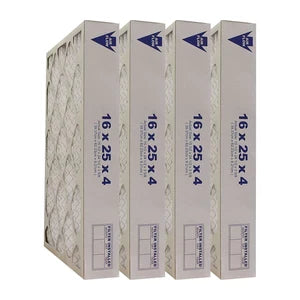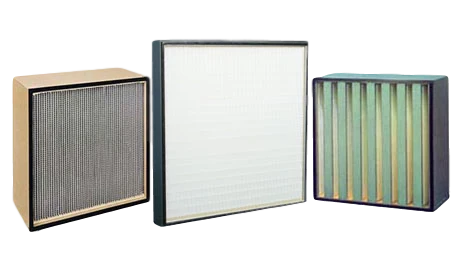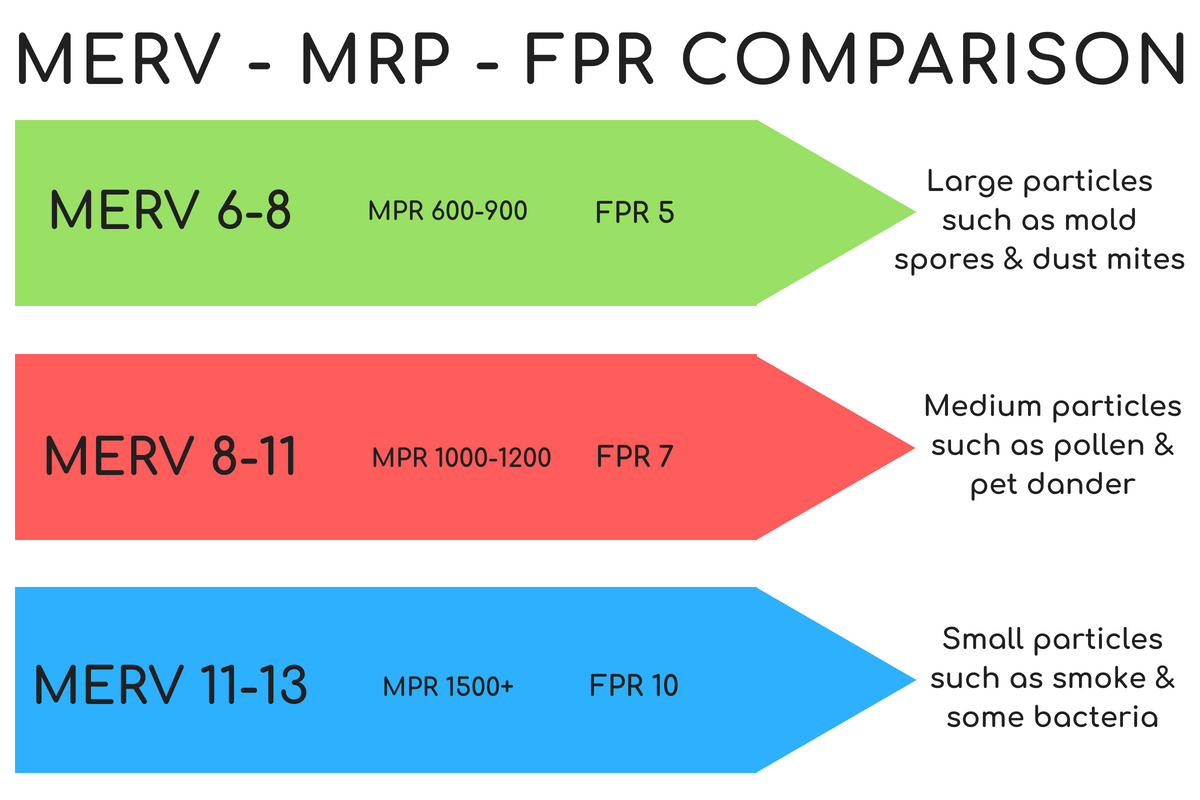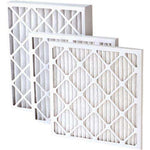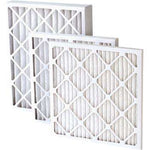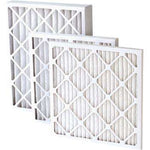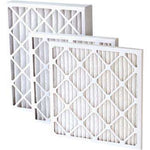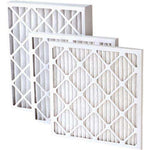Vous avez pas d'articles dans votre panier.
A Quick Guide To Finding the Best-Rated Furnace Filter For Your Home
If you’re a homeowner, you’ve needed to change your air filter from time to time.
Replacing your air filter in time prevents dust, pollen, mold spores, and other contaminants from floating around in your home. This helps keep allergies, stuffy noses, and bizarre flus away.
When you go about changing your air filter, you’ll encounter all kinds of options, each with a different rating. If you’ve never done it before, you’ll likely find yourself wondering which option to choose.
Well, that’s what we’ll discuss in today’s feature. We’ll discuss the different air filter ratings, MERV, MPR, and FPR, telling you what you need to know about each.
By the time we’re done, you’ll be swapping out filters the way Beyonce does vocal runs— effortlessly!

Understanding Air Filter Ratings
In the quest for cleaner indoor air, the significance of choosing the right air filter cannot be overstated.
Homeowners and businesses alike must navigate the maze of MERV, MPR, and FPR ratings to find the best option for their HVAC systems.
Today, we will demystify these ratings and explain their differences.
Whether you live in Canada or the USA, we hope this helps you make an informed decision about which air filter to use to improve your indoor air quality.
What is a MERV Rating?
MERV stands for Minimum Efficiency Reporting Value. It is a standard that measures how effectively a filter can capture larger particles between 0.3 to 10 microns (µm).
Developed by the American Society of Heating, Refrigerating, and Air-Conditioning Engineers (ASHRAE), this rating is an industry standard used worldwide.
The MERV air filter rating system ranges from 1 to 20, with higher numbers indicating a filter's ability to remove finer particles.
A higher MERV rating typically involves a trade-off with airflow, as denser filters reduce the air flow rate through your HVAC system.
You should, therefore, be wary of installing filters with higher MERV ratings than your HVAC can handle.
The only thing you’ll accomplish is less air and an overworking HVAC unit. That’s not good for your system but don’t worry— we’ll talk about this in a bit.
Understanding MPR (Microparticle Performance Rating)
Developed by 3M, the MPR rating, or Microparticle Performance Rating, focuses specifically on the filter’s capacity to capture particles smaller than 1 micron (1 µm).
MPR ratings help consumers compare the performance of different filters made by different companies.
These ratings range from 300 to 2200, with higher numbers indicating better filtration capabilities.
The MPR system is particularly useful when looking for filters that can capture microscopic pollutants, like smoke, bacteria, spores, and dander.
For this reason, it is commonly used by hospitals, restaurants, and other establishments that require hospital-grade air filtration.

What Does FPR Mean On Air Filters?
FPR, or Filter Performance Rating, was created by Home Depot as an exclusive in-house rating system for brands sold through its retail outlets.
This was done to make it easier for consumers to compare different air filters.
The air filter FPR rating system is similar to MERV and uses a numerical scale ranging from 4 to 10, which corresponds generally to a MERV rating scale from 4 to 13.
Additionally, FPR includes color codes to help consumers easily identify the level of filtration they require.
While this air filter rating system is not an industry standard, it certainly makes things easier for customers shopping for filters at Home Depot stores. FPR scores are based on the following:
-
How efficiently the filter captures particles
-
How easy it is for air to flow through the filters
-
How long the filter works effectively without needing replacement
-
How effective they are in getting rid of cooking smells and other odors
Comparison Chart Overview
Here’s a quick reference guide that compares MERV, MPR, and FPR ratings:
-
MERV 6-8 (FPR 4-5, MPR 300-600): Ideal for basic residential use, capturing pollen, dust mites, and spray paint dust. These filters may also offer some protection against pet dander, but not completely. If you live with pets, we recommend filters with a higher MERV rating.
-
MERV 9-12 (FPR 6-7, MPR 600-1200): These offer higher-grade filtration, and are better for homes with pets. They’re also adept at capturing mold spores, hairspray, and other common air pollutants.
-
MERV 13-16 (FPR 8-10, MPR 1500-2200): If you’re looking for hospital-level filtration, these are the best furnace air filter ratings for you. Best for those with allergies or asthma, capable of capturing tobacco smoke, sneeze particles, and microbial particles. Besides being the best air filters for asthma, they are also great for restaurants, office buildings, and other establishments with high filtration needs.
MPR vs MERV vs FPR Comparison: Which Rating Should You Use?
If it’s your first time shopping for air filters, you may find it hard to choose the best option for you. And with three different air filter ratings to consider, you’re likely wondering which one to use. Well, let’s discuss all of them, and soon you’ll know which one to work with.
MERV Rating Usage
-
Low MERV (6-8): Basic filtration levels. Suitable for households without pets, allergies, or asthma.
-
Medium MERV (9-12): Moderate filtration levels. Good for urban homes with moderate allergies and pets.
-
High MERV (13-16): Necessary for superior air quality needs, including homes in polluted areas or with family members who have respiratory conditions.
MPR Rating Usage
-
MPR 300-600: Comparable to low MERV ratings, these filters are adequate for basic residential needs.
-
MPR 1000-1200: These filters provide a balance of airflow and particulate capture that benefits most homes.
-
MPR 1500-2200: High-performance filters ideal for capturing a wide range of contaminants.
FPR Rating Usage
-
FPR 4-5: Basic filtration is good for clean homes without special requirements.
-
FPR 6-7: Better for homes needing moderate filtration but where airflow is also a concern.
-
FPR 8-10: High filtration, recommended for families needing superior air quality.
Air Filter Rating Systems Comparison Table
|
Feature |
MERV (Minimum Efficiency Reporting Value) |
MPR (Microparticle Performance Rating) |
FPR (Filter Performance Rating) |
|---|---|---|---|
|
Origin |
Developed by the American Society of Heating, Refrigerating, and Air-Conditioning Engineers (ASHRAE). |
Created by 3M specifically to measure filter efficiency at capturing particles smaller than 1 micron. |
Introduced by Home Depot to rate filters sold in its stores based on their ability to capture larger particles. |
|
Rating Range |
1-16, with higher numbers indicating better filtration of finer particles. |
300 to 2200, focused specifically on particles smaller than 1 micron. |
4-10, often color-coded for easier understanding and shopping. |
|
Measured Particle Size |
Measures a range of particle sizes from 0.3 to 10 microns. |
Focuses on micro-particles specifically from 0.3 to 1 micron—ideal for smoke, bacteria, and other tiny particulates. |
Less specific, generally aligned with larger particle sizes compared to MERV and MPR. |
|
Industry Adoption |
Widely used internationally across various industries for both residential and commercial HVAC systems. |
Limited to products related to 3M, which might not be available or preferred everywhere. |
Exclusive to Home Depot, thus its applicability is limited to filters sold there. |
|
Why Prefer MERV? |
Standardized and widely recognized, provides a broader understanding of a filter’s capabilities across a variety of particle sizes. Offers consistent expectations for air quality improvement. |
While excellent for specific needs (small particles), it might not provide a complete picture of a filter's overall efficiency. |
Though useful for in-store comparisons, it lacks the broader industry recognition which can limit its utility in professional settings. |

Practical Advice for Homeowners
If you’re a new homeowner wondering how to stay on top of your HVAC maintenance, we can help.
Here are a few tips to keep in mind when choosing a furnace air filter and installing it:
1. Assess Your Needs: Consider allergies, pets, and air quality in your area.
2. Consult HVAC Specifications: Ensure the filter is compatible with your HVAC system to avoid restricted airflow that can strain the system and increase energy bills.
3. Regular Replacement: To maintain optimal air quality and system efficiency, replace filters regularly according to the manufacturer's guidelines.
4. Ensure the dimensions match: Whether you’re installing a MERV 8 or MERV 13 filter, it’s crucial to make sure its dimensions match those of your furnace.
You don’t want to swap your filter out with one that’s too small or too big. This could lead to unfiltered air being circulated around the room, or your HVAC struggling to maintain airflow.
Frequently Asked Questions
What’s the Difference Between MERV, MPR, and FPR Air Filter Ratings?
The MERV air filter rating system is an industry standard that was developed by engineers.
FPR was introduced by Home Depot to make it easier for shoppers to distinguish between different air filters.
The MPR system, on the other hand, was developed by 3M, a trusted and reputable company that makes and sells air filters.
Like FPR, the MPR system is not an industry standard, but it also makes things a lot easier for customers all around the world.
Is a Higher MERV Rating Always Better?
Not necessarily. The best MERV rating is the one that’s compatible with your HVAC unit while meeting your air filtration needs.
You should also consider factors such as seasonal contaminants. These include dust and pollen, which can make life hell for people with sensitive allergies.
When changing out your filter, ensure to replace one with a MERV rating that addresses your changing needs and concerns.
Can Using a High MERV Filter Damage My AC?
Absolutely! Unfortunately, while high MERV filters provide the best air filtration, they also limit airflow.
This causes your furnace to work a little harder getting the air to flow through the filters, which could cause the system to overheat. Over time, this may lead to mechanical problems, affecting the unit’s lifespan.
If you want to keep your AC running optimally for the longest, we recommend choosing a filter with a corresponding MERV rating. You may find this info in the unit’s manufacturer’s manual.
What MERV Rating Should I Use If I Have Pets Or Allergies?
A home with a pet has more pressing filtrating demands than a house that doesn’t.
This is because of pet dander, dust, mites, and other contaminants your furry friends may bring home.
You’ll, therefore, need air filters that can handle these needs.
If you’re looking for pet-friendly air filters, we recommend something with a MERV rating of 11+. This corresponds to an MPR rating of about 1200+, and an air filter FPR rating of 8+.
On the other hand, if you or other people in your home suffer from allergies, you should choose something with even higher air filter ratings.
This is because you’ll need protection against viruses, bacteria, mold spores, and other microscopic allergens.
Customers looking for allergy-relief furnace filters will benefit from options with a MERV rating of 11-13. This corresponds to air filter MPR ratings of 1200-1500, and an air filter FPR rating of 10.
How Often Should I Replace My Furnace Filter?
Well, that will depend on numerous factors.
For one, what type of filter do you have? Higher rated filters, such as MERV 11 and up, capture almost all pollutants in the air, thus are known to fill up faster. You should take this out every 1-2 months.
In contrast, filters with a lower rating, such as MERV 6 - 8, will last a while before they clog up with lint and dust. These could stay in for 2-3 months.
You should also consider your needs. If you have pets, flowering indoor plants, young children, or serious allergies, you should change your filter more regularly, say every month and a half.
Final Thoughts: Air Filter Rankings Debunked
Choosing the right air filter involves understanding the differences between MERV, MPR, and FPR ratings.
By selecting a filter that fits your specific needs, you can improve the air quality in your home or office, enhance the efficiency of your HVAC system, and potentially reduce the impact of indoor allergens on your health.
Whether you opt for a MERV, MPR, or FPR rated filter, the key is to prioritize your health and comfort while also considering the operational efficiency of your system.
At United Filters, our goal is to help you accomplish this effortlessly and cost-effectively.
Place an order today, and we’ll send it right to you.
A Quick Guide To Finding the Best-Rated Furnace Filter For Your Home
If you’re a homeowner, you’ve needed to change your air filter from time to time.
Replacing your air filter in time prevents dust, pollen, mold spores, and other contaminants from floating around in your home. This helps keep allergies, stuffy noses, and bizarre flus away.
When you go about changing your air filter, you’ll encounter all kinds of options, each with a different rating. If you’ve never done it before, you’ll likely find yourself wondering which option to choose.
Well, that’s what we’ll discuss in today’s feature. We’ll discuss the different air filter ratings, MERV, MPR, and FPR, telling you what you need to know about each.
By the time we’re done, you’ll be swapping out filters the way Beyonce does vocal runs— effortlessly!

Understanding Air Filter Ratings
In the quest for cleaner indoor air, the significance of choosing the right air filter cannot be overstated.
Homeowners and businesses alike must navigate the maze of MERV, MPR, and FPR ratings to find the best option for their HVAC systems.
Today, we will demystify these ratings and explain their differences.
Whether you live in Canada or the USA, we hope this helps you make an informed decision about which air filter to use to improve your indoor air quality.
What is a MERV Rating?
MERV stands for Minimum Efficiency Reporting Value. It is a standard that measures how effectively a filter can capture larger particles between 0.3 to 10 microns (µm).
Developed by the American Society of Heating, Refrigerating, and Air-Conditioning Engineers (ASHRAE), this rating is an industry standard used worldwide.
The MERV air filter rating system ranges from 1 to 20, with higher numbers indicating a filter's ability to remove finer particles.
A higher MERV rating typically involves a trade-off with airflow, as denser filters reduce the air flow rate through your HVAC system.
You should, therefore, be wary of installing filters with higher MERV ratings than your HVAC can handle.
The only thing you’ll accomplish is less air and an overworking HVAC unit. That’s not good for your system but don’t worry— we’ll talk about this in a bit.
Understanding MPR (Microparticle Performance Rating)
Developed by 3M, the MPR rating, or Microparticle Performance Rating, focuses specifically on the filter’s capacity to capture particles smaller than 1 micron (1 µm).
MPR ratings help consumers compare the performance of different filters made by different companies.
These ratings range from 300 to 2200, with higher numbers indicating better filtration capabilities.
The MPR system is particularly useful when looking for filters that can capture microscopic pollutants, like smoke, bacteria, spores, and dander.
For this reason, it is commonly used by hospitals, restaurants, and other establishments that require hospital-grade air filtration.

What Does FPR Mean On Air Filters?
FPR, or Filter Performance Rating, was created by Home Depot as an exclusive in-house rating system for brands sold through its retail outlets.
This was done to make it easier for consumers to compare different air filters.
The air filter FPR rating system is similar to MERV and uses a numerical scale ranging from 4 to 10, which corresponds generally to a MERV rating scale from 4 to 13.
Additionally, FPR includes color codes to help consumers easily identify the level of filtration they require.
While this air filter rating system is not an industry standard, it certainly makes things easier for customers shopping for filters at Home Depot stores. FPR scores are based on the following:
-
How efficiently the filter captures particles
-
How easy it is for air to flow through the filters
-
How long the filter works effectively without needing replacement
-
How effective they are in getting rid of cooking smells and other odors
Comparison Chart Overview
Here’s a quick reference guide that compares MERV, MPR, and FPR ratings:
-
MERV 6-8 (FPR 4-5, MPR 300-600): Ideal for basic residential use, capturing pollen, dust mites, and spray paint dust. These filters may also offer some protection against pet dander, but not completely. If you live with pets, we recommend filters with a higher MERV rating.
-
MERV 9-12 (FPR 6-7, MPR 600-1200): These offer higher-grade filtration, and are better for homes with pets. They’re also adept at capturing mold spores, hairspray, and other common air pollutants.
-
MERV 13-16 (FPR 8-10, MPR 1500-2200): If you’re looking for hospital-level filtration, these are the best furnace air filter ratings for you. Best for those with allergies or asthma, capable of capturing tobacco smoke, sneeze particles, and microbial particles. Besides being the best air filters for asthma, they are also great for restaurants, office buildings, and other establishments with high filtration needs.
MPR vs MERV vs FPR Comparison: Which Rating Should You Use?
If it’s your first time shopping for air filters, you may find it hard to choose the best option for you. And with three different air filter ratings to consider, you’re likely wondering which one to use. Well, let’s discuss all of them, and soon you’ll know which one to work with.
MERV Rating Usage
-
Low MERV (6-8): Basic filtration levels. Suitable for households without pets, allergies, or asthma.
-
Medium MERV (9-12): Moderate filtration levels. Good for urban homes with moderate allergies and pets.
-
High MERV (13-16): Necessary for superior air quality needs, including homes in polluted areas or with family members who have respiratory conditions.
MPR Rating Usage
-
MPR 300-600: Comparable to low MERV ratings, these filters are adequate for basic residential needs.
-
MPR 1000-1200: These filters provide a balance of airflow and particulate capture that benefits most homes.
-
MPR 1500-2200: High-performance filters ideal for capturing a wide range of contaminants.
FPR Rating Usage
-
FPR 4-5: Basic filtration is good for clean homes without special requirements.
-
FPR 6-7: Better for homes needing moderate filtration but where airflow is also a concern.
-
FPR 8-10: High filtration, recommended for families needing superior air quality.
Air Filter Rating Systems Comparison Table
|
Feature |
MERV (Minimum Efficiency Reporting Value) |
MPR (Microparticle Performance Rating) |
FPR (Filter Performance Rating) |
|---|---|---|---|
|
Origin |
Developed by the American Society of Heating, Refrigerating, and Air-Conditioning Engineers (ASHRAE). |
Created by 3M specifically to measure filter efficiency at capturing particles smaller than 1 micron. |
Introduced by Home Depot to rate filters sold in its stores based on their ability to capture larger particles. |
|
Rating Range |
1-16, with higher numbers indicating better filtration of finer particles. |
300 to 2200, focused specifically on particles smaller than 1 micron. |
4-10, often color-coded for easier understanding and shopping. |
|
Measured Particle Size |
Measures a range of particle sizes from 0.3 to 10 microns. |
Focuses on micro-particles specifically from 0.3 to 1 micron—ideal for smoke, bacteria, and other tiny particulates. |
Less specific, generally aligned with larger particle sizes compared to MERV and MPR. |
|
Industry Adoption |
Widely used internationally across various industries for both residential and commercial HVAC systems. |
Limited to products related to 3M, which might not be available or preferred everywhere. |
Exclusive to Home Depot, thus its applicability is limited to filters sold there. |
|
Why Prefer MERV? |
Standardized and widely recognized, provides a broader understanding of a filter’s capabilities across a variety of particle sizes. Offers consistent expectations for air quality improvement. |
While excellent for specific needs (small particles), it might not provide a complete picture of a filter's overall efficiency. |
Though useful for in-store comparisons, it lacks the broader industry recognition which can limit its utility in professional settings. |

Practical Advice for Homeowners
If you’re a new homeowner wondering how to stay on top of your HVAC maintenance, we can help.
Here are a few tips to keep in mind when choosing a furnace air filter and installing it:
1. Assess Your Needs: Consider allergies, pets, and air quality in your area.
2. Consult HVAC Specifications: Ensure the filter is compatible with your HVAC system to avoid restricted airflow that can strain the system and increase energy bills.
3. Regular Replacement: To maintain optimal air quality and system efficiency, replace filters regularly according to the manufacturer's guidelines.
4. Ensure the dimensions match: Whether you’re installing a MERV 8 or MERV 13 filter, it’s crucial to make sure its dimensions match those of your furnace.
You don’t want to swap your filter out with one that’s too small or too big. This could lead to unfiltered air being circulated around the room, or your HVAC struggling to maintain airflow.
Frequently Asked Questions
What’s the Difference Between MERV, MPR, and FPR Air Filter Ratings?
The MERV air filter rating system is an industry standard that was developed by engineers.
FPR was introduced by Home Depot to make it easier for shoppers to distinguish between different air filters.
The MPR system, on the other hand, was developed by 3M, a trusted and reputable company that makes and sells air filters.
Like FPR, the MPR system is not an industry standard, but it also makes things a lot easier for customers all around the world.
Is a Higher MERV Rating Always Better?
Not necessarily. The best MERV rating is the one that’s compatible with your HVAC unit while meeting your air filtration needs.
You should also consider factors such as seasonal contaminants. These include dust and pollen, which can make life hell for people with sensitive allergies.
When changing out your filter, ensure to replace one with a MERV rating that addresses your changing needs and concerns.
Can Using a High MERV Filter Damage My AC?
Absolutely! Unfortunately, while high MERV filters provide the best air filtration, they also limit airflow.
This causes your furnace to work a little harder getting the air to flow through the filters, which could cause the system to overheat. Over time, this may lead to mechanical problems, affecting the unit’s lifespan.
If you want to keep your AC running optimally for the longest, we recommend choosing a filter with a corresponding MERV rating. You may find this info in the unit’s manufacturer’s manual.
What MERV Rating Should I Use If I Have Pets Or Allergies?
A home with a pet has more pressing filtrating demands than a house that doesn’t.
This is because of pet dander, dust, mites, and other contaminants your furry friends may bring home.
You’ll, therefore, need air filters that can handle these needs.
If you’re looking for pet-friendly air filters, we recommend something with a MERV rating of 11+. This corresponds to an MPR rating of about 1200+, and an air filter FPR rating of 8+.
On the other hand, if you or other people in your home suffer from allergies, you should choose something with even higher air filter ratings.
This is because you’ll need protection against viruses, bacteria, mold spores, and other microscopic allergens.
Customers looking for allergy-relief furnace filters will benefit from options with a MERV rating of 11-13. This corresponds to air filter MPR ratings of 1200-1500, and an air filter FPR rating of 10.
How Often Should I Replace My Furnace Filter?
Well, that will depend on numerous factors.
For one, what type of filter do you have? Higher rated filters, such as MERV 11 and up, capture almost all pollutants in the air, thus are known to fill up faster. You should take this out every 1-2 months.
In contrast, filters with a lower rating, such as MERV 6 - 8, will last a while before they clog up with lint and dust. These could stay in for 2-3 months.
You should also consider your needs. If you have pets, flowering indoor plants, young children, or serious allergies, you should change your filter more regularly, say every month and a half.
Final Thoughts: Air Filter Rankings Debunked
Choosing the right air filter involves understanding the differences between MERV, MPR, and FPR ratings.
By selecting a filter that fits your specific needs, you can improve the air quality in your home or office, enhance the efficiency of your HVAC system, and potentially reduce the impact of indoor allergens on your health.
Whether you opt for a MERV, MPR, or FPR rated filter, the key is to prioritize your health and comfort while also considering the operational efficiency of your system.
At United Filters, our goal is to help you accomplish this effortlessly and cost-effectively.
Place an order today, and we’ll send it right to you.
